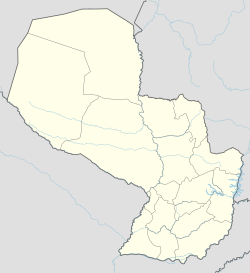This article needs additional citations for verification. (May 2024) |
Villarrica | |
|---|---|
| Villarrica del Espíritu Santo | |
 Villarrica, Paraguay | |
| Nickname: Wandering City. Culture Capital. | |
| Motto: Plus Ultra (latin further beyond) | |
| Coordinates: 25°45′S 56°26′W / 25.750°S 56.433°W | |
| Country | |
| Department | Guairá |
| Founded | May 14, 1570 |
| Founded by | Ruy Diaz Melgarejo |
| Government | |
| • Intendente Municipal | Magin Benítez (PLRA) |
| Area | |
| • Total | 247 km2 (95 sq mi) |
| Elevation | 200 m (700 ft) |
| Population | |
| • Total | 74,355 |
| • Density | 300/km2 (780/sq mi) |
| Time zone | UTC-04 (AST) |
| • Summer (DST) | UTC-03 (ADT) |
| Postal code | 5000 |
| Area code | +595 (541) |
Villarrica del Espíritu Santo (Spanish pronunciation: [ˌbiʎaˈrika ðel esˈpiɾitu ˈsanto]), is a city in Paraguay. Located in the middle of the Eastern Region of Paraguay. It is the capital and most populous city of Guairá Department.
It is located to the center west of Guairá and is bordered to the east by the towns of Mbocayaty and Yataity, to the west by Itapé and Félix Pérez, to the east by Independencia, Ñumí and Garay, and to the south by San Salvador and Borja.
Founded in 1570 by Sevillian Ruy Díaz de Melgarejo, it is one of the oldest settlements in Paraguay. Nevertheless, the original foundation site was located within the extinct Spanish province of Guayra in what is now the state of Parana in Brazil. The residents of Villarrica were forced to relocate seven times during a timespan of more than 100 years. These relocations were mainly caused by the repeated attacks from the neighbouring portuguese bandeirantes but also by political and economical issues. They were finally settled in its current location near Ybytyruzu hills in 1683. As a result, the city got the nickname of "Wandering City".[1]
After the end of the Paraguayan War in 1870, Villarrica experimented a rapid economical and populational growth becoming the second most important Paraguayan city after the capital Asuncion. Nowadays, the city is still a well-known cultural hub.
- ^ "La ciudad andariega" (in Spanish).


